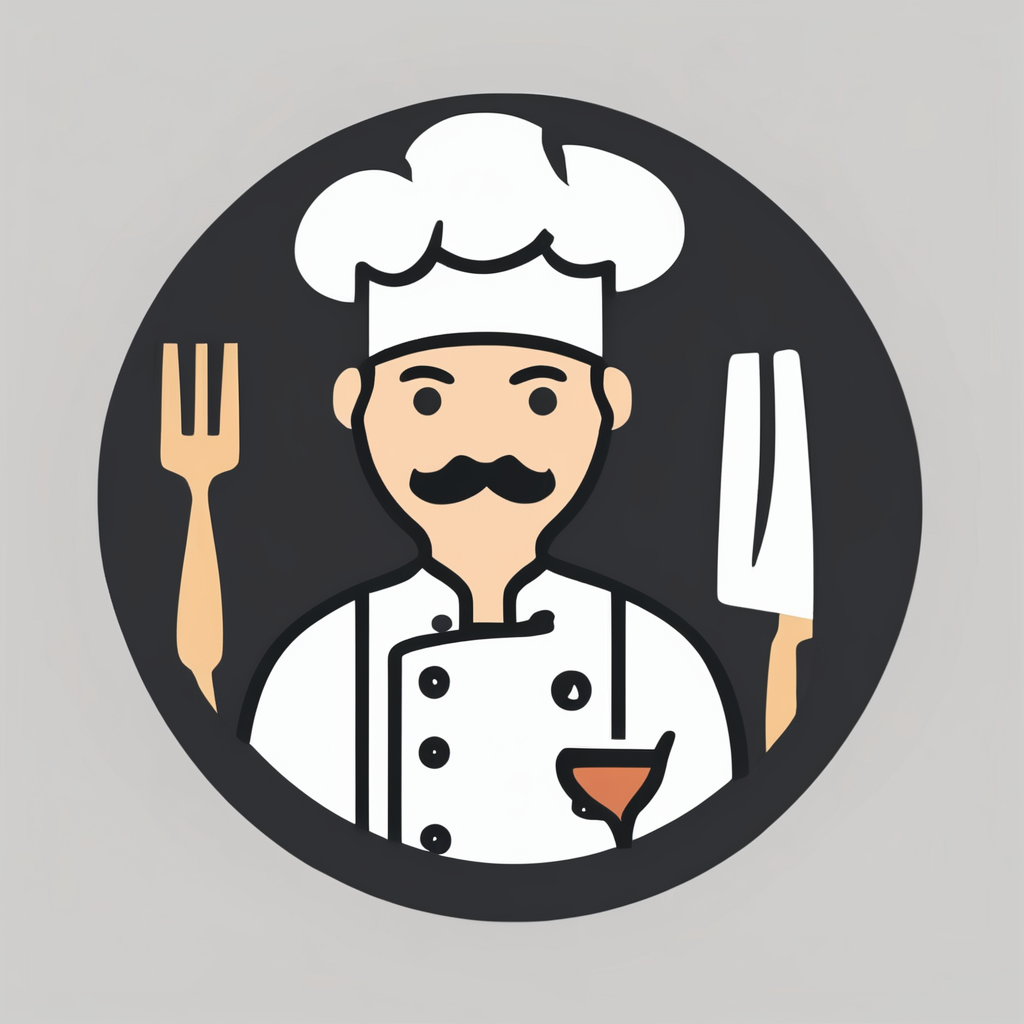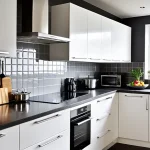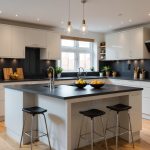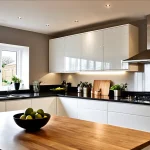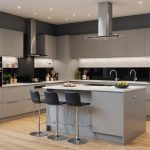Essential Elements Shaping Successful UK Kitchen Restaurant Bar Design
A successful UK kitchen restaurant bar design hinges on mastering several essential elements that blend functionality with guest experience. The backbone is a functional kitchen workflow and space planning. Efficiently arranged workstations reduce staff movement, speeding up service while maintaining food quality. Thoughtful spacing helps prevent collisions and fatigue, crucial during peak hours.
Equally crucial is an effective bar layout and guest flow. The bar area must cater to both staff efficiency and customer comfort. A well-designed bar encourages natural movement, minimizing congestion while maximizing seating. This keeps the environment inviting and lively, essential for a thriving restaurant bar.
Also to read : How do UK kitchen bars create a unique atmosphere for patrons?
Furthermore, integrating hospitality industry best practices is vital. This means embracing designs that accommodate flexibility for staff and customers, ensuring safety and hygiene, and using technology to streamline operations. These principles elevate overall service, making the establishment not just a place to eat and drink, but an experience.
Incorporating these design principles forms the core of a successful UK kitchen restaurant bar design. They maximize operational efficiency and create an inviting atmosphere, balancing the needs of staff and guests seamlessly.
Additional reading : How do UK kitchens maintain hygiene standards during busy hours?
Optimising Kitchen Workflow and Space Utilisation
Efficient kitchen workflow is essential to enhance restaurant efficiency UK-wide. By zoning distinct areas for food preparation, cooking, and service, kitchens avoid bottlenecks and improve task flow. This zoning means that chefs and staff can focus without interruption, reducing delays and minimizing errors.
For effective space utilisation, placing equipment strategically helps maximise operational speed. For example, ovens and stoves should be near prep areas but separated enough to allow free movement. Storage solutions like adjustable shelving and under-counter units free up valuable workspace, maintaining accessibility while complying with UK hygiene standards.
Maximising kitchen efficiency for UK restaurants also involves designing the layout to accommodate peak periods without overcrowding, ensuring health and safety guidelines are met. Incorporating modular workstations and mobile trolleys can adapt the kitchen space dynamically depending on varying demands.
In summary, a well-planned kitchen workflow coupled with smart space utilisation boosts productivity. It reduces staff fatigue and waste, ultimately improving service quality and profitability in the competitive UK market.
Bar Layout and Customer Movement Strategies
Effective bar layout plays a crucial role in enhancing customer experience and operational efficiency. In the UK, thoughtful bar area design prioritizes strategic placement of the bar to ensure easy accessibility for patrons. Positioning the bar centrally or along high-traffic zones allows customers to approach with minimal obstruction.
Smooth customer flow is vital, especially during peak service times. Designing clear circulation paths prevents bottlenecks and supports timely service. This includes separate entry and exit points, as well as dedicated routes for staff to minimize cross-traffic. When patrons move freely, it boosts satisfaction and increases turnover rates.
To handle high footfall, layouts often feature spacious service counters and waiting areas. Incorporating multiple service stations can disperse crowds, reducing wait times. Additionally, employing visual cues like floor patterns or lighting guides customers intuitively through the space.
Balancing aesthetic appeal with functionality ensures that a bar area design UK complements both the venue’s style and operational needs. This approach enhances the overall environment, making visits enjoyable and efficient for customers and staff alike.
Meeting UK Regulations and Health & Safety Standards
Understanding UK restaurant regulations is critical to create a safe and legally compliant dining environment. Key areas include health and safety, accessibility, fire safety, and food hygiene, which all must be addressed during the restaurant’s design and layout phase.
Specifically, accessibility standards require restaurants to provide reasonable adjustments, such as wheelchair access and adequate restroom facilities. Fire safety regulations focus on proper exits, fire alarms, and extinguishers to protect guests and staff. Food hygiene laws mandate strict controls on food preparation areas, storage, and handling to prevent contamination.
Ensuring compliance means consulting relevant legislation like the Food Safety Act and the Regulatory Reform (Fire Safety) Order. Early collaboration with architects and health and safety officers helps integrate these requirements seamlessly. Regular staff training further supports ongoing adherence.
Careful attention during planning reduces costly retrofits later, promoting a safe, welcoming atmosphere that aligns with UK restaurant regulations and enhances customer confidence. Meeting these standards is not just a legal obligation but a fundamental step in building a successful hospitality venue.
Aesthetics, Lighting, and Ambience in Restaurant Bar Design
Enhancing experience through thoughtful design
Lighting design plays a crucial role in shaping the ambience of a restaurant bar. Using layered lighting—combining overhead fixtures, task lights, and accent lights—allows spaces to feel inviting while remaining functional. For example, dimmable warm LEDs create a cozy atmosphere without compromising visibility for staff and patrons.
In terms of aesthetics, UK interior trends favor natural materials like reclaimed wood and stone, paired with matte finishes that soften reflections. Colour schemes trend towards muted tones such as deep greens, charcoal greys, and soft terracottas, which add warmth and depth. These colours complement lighting choices and enhance the overall mood.
Current trends emphasize a balance of modern minimalism with rustic touches—think exposed brick walls illuminated by carefully placed pendant lamps. This approach ensures the setting feels both stylish and approachable.
By thoughtfully integrating lighting design with material and colour choices, restaurant bars can craft an ambience that elevates the dining and drinking experience, encouraging customers to relax and linger longer.
Furniture and Fixtures Selection for UK Restaurants and Bars
Durability and style in busy environments
Choosing the right furniture selection for UK restaurants and bars is crucial for both aesthetics and functionality. Establishments face constant use, so selecting durable furniture is essential to withstand high traffic without compromising style. Opting for materials like hardwood, reinforced upholstery, or metal frames can ensure longevity, cutting down replacement costs.
Balancing comfort with space efficiency is another key consideration. Compact designs that allow ample seating without overcrowding improve customer experience and optimize floor layout. For bar seating, choosing stools with footrests and ergonomic support encourages longer stays and repeat visits.
It’s also important that all UK restaurant fixtures comply with local quality and fire safety standards. Furniture should meet British safety regulations, including fire retardancy, to prioritize patron safety. Certifications and thorough supplier vetting can help establishments avoid compliance issues and maintain a reputable setting.
By focusing on resilience, comfort, and regulatory adherence, restaurant and bar owners create inviting spaces where customers return again and again.
Expert Tips and Best Practices for UK Kitchen Restaurant Bar Design
Creating a functional and inviting restaurant bar is pivotal in UK dining spaces. Start with a restaurant bar checklist focusing on layout efficiency, customer flow, and service speed. Position the bar so staff can quickly reach the kitchen, minimizing delays and maximizing interaction.
UK best practices emphasize balancing aesthetics with practicality. Use durable, easy-to-clean materials that withstand heavy use while maintaining style. Lighting should highlight the bar area without overpowering the ambiance. Incorporate both ambient and task lighting to meet different needs.
Professional advice recommends considering storage solutions carefully—ample shelving and refrigerated units help streamline drink preparation. Accessibility is crucial, including clear sightlines and intuitive navigation for guests and staff alike.
Visual examples from premier UK venues often showcase bars with modular designs that adapt to varying crowd sizes. Integrating technology such as POS systems near the bar can enhance service efficiency.
Implementing these expert tips within your restaurant bar design ensures smooth operations, boosts customer satisfaction, and ultimately enhances your venue’s reputation in the competitive UK market.
